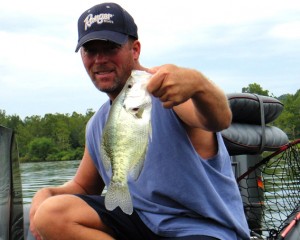Editor’s Note: This column first appeared in The Greater Ashland Beacon on Sept. 7, 2011.
By Chris Erwin
Crappie fishing, according to the Department of Fish and Wildlife, is done 62 percent of the time with tube jigs. The remainder is done using live minnows.
But every year there comes a time when those of us who stay up on crappie fishing know there is another bait that will catch some of the largest crappie in the lake. From the title of the article, I’m sure you have already guessed it but if not, it’s crankbaits.
Small crankbaits such as the Baby N, made by Norman lures, is a good example of the bait I’m talking about. The medium runner is a good choice and while there are many colors at your disposal, I like a bone or white with a blue or chartreuse back. To be the most effective, you should also go down in line weight to about 10 or 12 pound test on either casting or spinning gear. Going down in line weight will let your lure get a little deeper. During this time of the year most lakes are clear so the small diameter line also makes your line practically invisible.
One of the members of KentuckyAngling.com who helps us put together the fishing report each week is Scott Doan. He lives near Cave Run Lake and is on the water almost every week. For the last few weeks, he has been catching big crappie using this small crankbait method. This method works on all lakes where crappie and shad reside.

In his report, Doan said that finding brush plies in 10 to 12 feet of water on flats has been the key to his success. Casting the edges of these brush piles has been very productive for him, he reports catching five to 10 fish on each pile. Doan moves slowly around each pile making one cast after another. As his bait passes the target zone on his retrieve, he pauses. Some fish will strike your bait just as you begin your retrieve after a two or three count pause.
Another Tip: Crappie have a soft paper thin mouth so a hard hook set is not necessary. In many cases all you need to do is lift the rod; this will help to prevent tearing out the hook.
As we start to move into the fall season, crappie become more aggressive. The larger fish will chase down shad while smaller fish tend to stay in the school. Jigs and minnows will still catch fish, but if you want to catch the larger slabs learning to use the crankbait method will put fish that you didn’t even know were there in the boat.
They are some other lures that will also catch these “brush pile” fish. However, the small crankbait is one that is preferred by many anglers because it has six hooks, it is easy to keep in the strike zone, and its fast fishing, moving from one brush pile to another.
It’s also always a good idea to keep a log of where you locate the brush piles. You can log these locations in the winter months when the water is at winter pool and many of these locations are out of the water or exposed. Logging them in the winter can pay big dividends in both the spring and fall when these locations will produce.
Boat position is also very important when fishing this structure, notice the wind direction and try to keep your boat in an area where the wind is not going to blow you into or directly on top of the brush pile. Your trolling motor can spook fish, rendering the location useless. Remember: Work the edges with multiple casts, once you catch a fish it’s rare that they are the only one in a location.
Till Next Time
Good fishing!



Be the first to comment